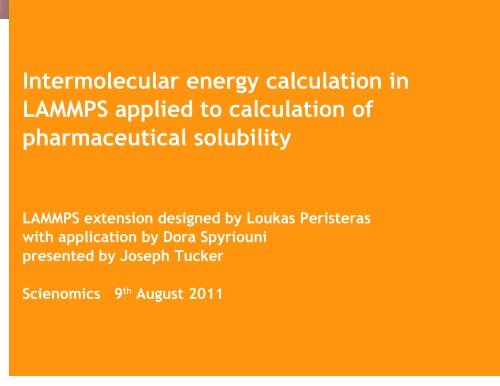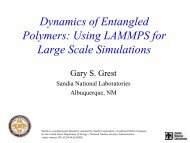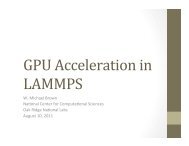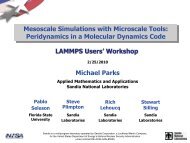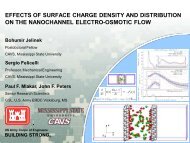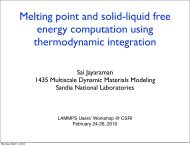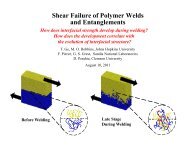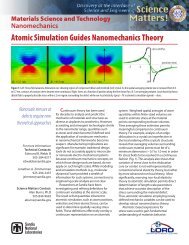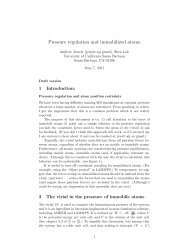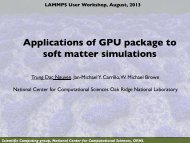Calculate pharmaceutical solubility using classical ... - Lammps
Calculate pharmaceutical solubility using classical ... - Lammps
Calculate pharmaceutical solubility using classical ... - Lammps
You also want an ePaper? Increase the reach of your titles
YUMPU automatically turns print PDFs into web optimized ePapers that Google loves.
Intermolecular energy calculation in<br />
LAMMPS applied to calculation of<br />
<strong>pharmaceutical</strong> <strong>solubility</strong><br />
LAMMPS extension designed by Loukas Peristeras<br />
with application by Dora Spyriouni<br />
presented by Joseph Tucker<br />
Scienomics 9 th August 2011
Calculating intermolecular energy -2<br />
intra<br />
inter<br />
parent chain<br />
image chain<br />
● Van der Wals: accurate with small cutoff = 2.5 sigma<br />
● electrostatic: needs larger cutoff, optionally use kspace
Calculating intermolecular energy -3<br />
compute approach, inter keyword<br />
e.g<br />
□ Define groups corresponding to molecular types:<br />
group H2O molecule 1 500<br />
group C3H8 molecule 501<br />
□ Use compute:<br />
compute 1 all inter H2O C3H8<br />
current status<br />
□ the compute works for all the atoms i.e. all atoms should be assigned<br />
to groups which identify the molecular types<br />
□ calculates the interaction with all the molecular types i.e molecule of<br />
type A with all the other molecular types A included.<br />
□ planning to refine the split i.e. for a system with molecular types A, B,<br />
C … to calculate A-A , A-B, A-C … interactions
Intermolecular energies for one conformation
<strong>Calculate</strong> <strong>pharmaceutical</strong> <strong>solubility</strong><br />
<strong>using</strong> <strong>classical</strong> simulation tools<br />
•<br />
We propose a scheme for the calculation of the <strong>solubility</strong><br />
of any organic molecule in any pure solvent.<br />
The proposed scheme is based on a simplification of the<br />
Particle Deletion Method (J. Chem. Phys. 2001, 115, 8231).<br />
The proposed scheme compares the energy and accessible<br />
volume of two systems:<br />
1) Pharmaceutical molecule + water<br />
2) Pharmaceutical molecule + any other solvent<br />
•<br />
No experimental data are required for this calculation<br />
except for the <strong>solubility</strong> of the molecule in water,<br />
which is used as the reference point for any <strong>solubility</strong> calculation.
<strong>Calculate</strong> the <strong>solubility</strong> of a molecule relative to its<br />
<strong>solubility</strong> in water: Visualization of the procedure<br />
STEP 1 : Simulate the organic molecule immersed in water<br />
Perform an NVT MD simulation<br />
<strong>using</strong> the LAMMPS engine.<br />
<strong>Calculate</strong> intermolecular energy of<br />
interaction (E 1<br />
) and<br />
accessible volume (Vacc 1<br />
) <strong>using</strong><br />
the analysis tools of MAPS.
STEP 2 : Simulate the organic molecule immersed in one solvent<br />
The solvent in the picture is MeOH.<br />
Perform an NPT MD simulation <strong>using</strong><br />
the LAMMPS engine.<br />
Similarly, calculate intermolecular<br />
energy of interaction (E 2<br />
) and<br />
accessible volume (Vacc 2<br />
).<br />
<strong>Calculate</strong> <strong>solubility</strong> in MeOH by an expression of the type:<br />
acc2<br />
S MeOH<br />
= S H2O<br />
x exp(1/kT x E – ln )<br />
V<br />
V<br />
acc1<br />
where S H2O<br />
is the <strong>solubility</strong> of the molecule in water
Comparison between calculated and experimental data<br />
of the <strong>solubility</strong> of a tentative set of molecules in MeOH<br />
API<br />
<strong>Calculate</strong>d<br />
<strong>solubility</strong><br />
(Mole fr.)<br />
Experimental<br />
<strong>solubility</strong><br />
(Mole fr.)<br />
Relative<br />
error<br />
Paracetamol 0.0630 0.0950 0.34<br />
Naproxen 0.0296 0.0120 1.47<br />
Trimethoprim 0.0011 0.0017 0.35<br />
Temazepam 0.0100 0.0055 0.83<br />
Butylparaben 0.0413 0.3360 0.88<br />
Diclofenac 0.0008 0.0059 0.86<br />
Carbamazepine 0.0130 0.0130 0.00<br />
Flurbiprofen 0.0278 0.0480 0.42<br />
Salicylamide 0.0374 0.0410 0.09<br />
AZD0865 0.0050 0.0014 2.46<br />
AZD8330 0.0050 0.0023 1.15
Comparison between calculated and experimental data of the<br />
<strong>solubility</strong> of a tentative set of molecules in acetone<br />
API<br />
<strong>Calculate</strong>d<br />
<strong>solubility</strong><br />
(Mole fr.)<br />
Experimental<br />
<strong>solubility</strong> (Mole<br />
fr.)<br />
Relative<br />
error<br />
Paracetamol 0.0390 0.0370 0.05<br />
Naproxen 0.0440 0.0500 0.12<br />
Trimethoprim 0.0160 0.0009 16.78<br />
Temazepam 0.0207 0.0207 0.00<br />
Butylparaben 0.1070 NA<br />
Diclofenac 0.0184 0.0302 0.39<br />
Carbamazepine 0.0216 0.0037 4.84<br />
Flurbiprofen 0.1250 0.1250 0.00<br />
Salicylamide 0.0530 0.1290 0.59<br />
AZD0865 0.0017 0.00018 8.55
The proposed scheme can be a valuable tool for<br />
<strong>pharmaceutical</strong> <strong>solubility</strong> predictions.<br />
<br />
It can be used as a supplementary tool to SciTherm<br />
equation of state calculations.
Experimental datasets – sharing and viewing<br />
“A disincentive to sharing data is that<br />
there is often grunt work involved in<br />
exporting, cleaning and documenting<br />
the dataset”<br />
MAPS enables researchers to share the<br />
definition and results of a LAMMPS experiment<br />
within a single file. Reviewers can view and<br />
analyse the results and attach annotations at<br />
any level.
Experimental datasets – MAPS file format<br />
<br />
<br />
<br />
298.15<br />
any number of experimental setup parameters...<br />
<br />
<br />
any number of molecule-level properties...<br />
complete set of bonds...<br />
INITIAL conformation definition = unitcell, other conformation-level properties<br />
and complete set of atoms with coordinates<br />
<br />
any number of GENERATED molecule-level properties...<br />
complete set of bonds...<br />
1..n GENERATED conformation definitions "0.000 ps" to "50.000 ps"<br />
= GENERATED conformation-level properties<br />
and complete set of atoms with coordinates<br />
<br />
files relating to this Experimental Result


